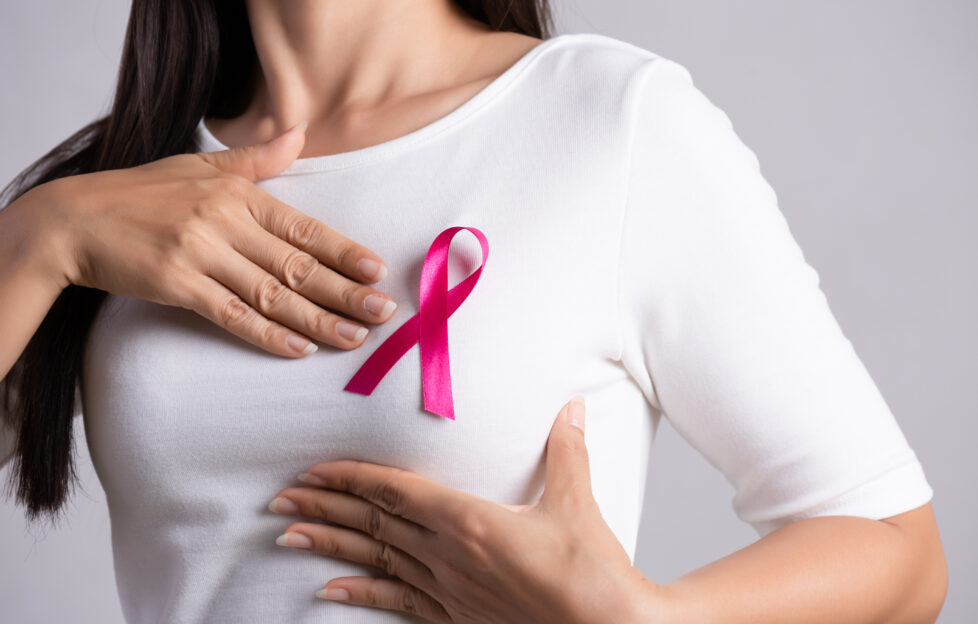 Shutterstock / siam.pukkato©
Shutterstock / siam.pukkato©To mark the beginning of Breast Cancer Awareness Month, Dr Petra Simic, Medical Director at Bupa UK Insurance, shares seven common misconceptions about this condition, symptoms to look out for, and how to check your breasts.
How to check your breasts
“When you’re checking your breasts, look at the size and shape of each breast and check for any lumps. Familiarise yourself with the way your breasts look normally, as this can help you spot anything unusual.
“Look at your breasts and the skin on and around them with your arms down at your sides, and then with your arms up in the air. Look for any areas where your skin is pulling, nipple discharge or red patches on the skin.
“Make sure you feel your breast, under your arm and behind the nipple for any lumps. Check each area for any pain when you’re touching them. Use the flat of your hand, pressing the tissue of the breast against your rib cage, feeling for lumps which may feel like marbles or grapes under your fingers.
“A good rule of thumb is to look out for any change that’s unexplained or persistent – and if you’re worried to seek medical advice”.
Eight symptoms of breast cancer
- A lump in the breast
- A lump in the armpit
- Nipple changes (such as a change to the shape or direction)
- Discharge from the nipple
- Changes to size or shape of breasts
- A change in skin texture (it may become dimpled or puckered)
- Change in the colour of the skin (it may look red)
- A skin rash (on or around the nipple)
Seven breast cancer misconceptions to avoid:
Myth 1: Finding a lump in your breast is always cancerous
If you notice a lump in your breast, it’s very important to get this checked by your doctor.
However, not all lumps are cancer – but they do need to be checked out.
It can be difficult opening up about your breast health, but it’s always best to reach out to your doctor for anything unusual. Your healthcare professional will want to hear about any changes you are concerned about.
Myth 2: I should check my breasts on the same day of every month
You should check your breasts whenever it’s convenient for you.
It’s important to get to know what is normal for you to help notice any changes.
A good time to check your breasts can be when you’re in the shower or bath. You should speak to your GP about any changes to how your breasts feel or look.
Myth 3: If I check my breasts regularly, I don’t need a mammogram
It’s important that you check your breasts regularly and attend your female health appointments.
A mammogram is a type of X-ray that can help find breast cancer at an early stage when treatment is most successful.
Anyone registered with a GP as female will be invited for NHS breast screening every three years between the ages of 50 and 71.
Cancers found during a mammogram may have been too small to see or be difficult to feel. This means you may not have noticed a change in appearance or touch.
Myth 4: Wearing a bra can cause cancer
There is no evidence that wearing a bra causes breast cancer.
The theory behind this misconception focuses on wearing an underwired bra, and a theory that the wiring restricts the flow of lymph fluid out of the breast. There is no scientific evidence to support this theory.
However, it is important that you wear a correctly fitting bra as not wearing the right sized or supportive bra can lead to breast pain.
Myth 5: Breast cancer is only a problem which affects women
This isn’t true: whilst each year in the UK, 55,000 women are diagnosed with breast cancer, 350 men are also diagnosed each year.
Although this is a much smaller number in comparison to women, it’s still important for men to report any changes to their doctor.
Having a close male family member (brother or father) with a history of breast cancer can mean you have a higher risk of having breast cancer, so make sure this information is shared with family members, or any medical professional if you are having breast issues.
Myth 6: I don’t have any symptoms, so I don’t need to attend screening appointments or health check ups
Female health checks and cancer screening across all ages are there to detect any early signs of abnormalities and cancer.
It’s important to attend all your female health checks and to know how to identify important changes in your own body.
Even if you’re showing no unusual symptoms, you should attend your checks and screening appointments as these can detect abnormalities before you start showing any symptoms.
Early detection is key to effectively treating cancers; attending all appointments – even if you’re feeling well – is vital.
Myth 7: I have a breast lump and I am due my routine screening mammogram, so I don’t need to see a doctor
Not all breast cancers are apparent on mammogram.
If you’ve found a breast abnormality you need to see your doctor, as you may need other tests in addition to a mammogram to rule out breast cancer.
Mammograms are designed for women without any symptoms and will pick up around 4 in 5 breast cancers.
They aren’t 100% accurate in showing if a person has breast cancer, so it shouldn’t replace seeing your GP if you have new symptoms.
If you’ve had a normal mammogram and subsequently find a lump or a change, it’s important you also see your GP just as urgently, as you may need an ultrasound scan or other tests to rule out breast cancer.
For more health tips from “The People’s Friend”, click here.




